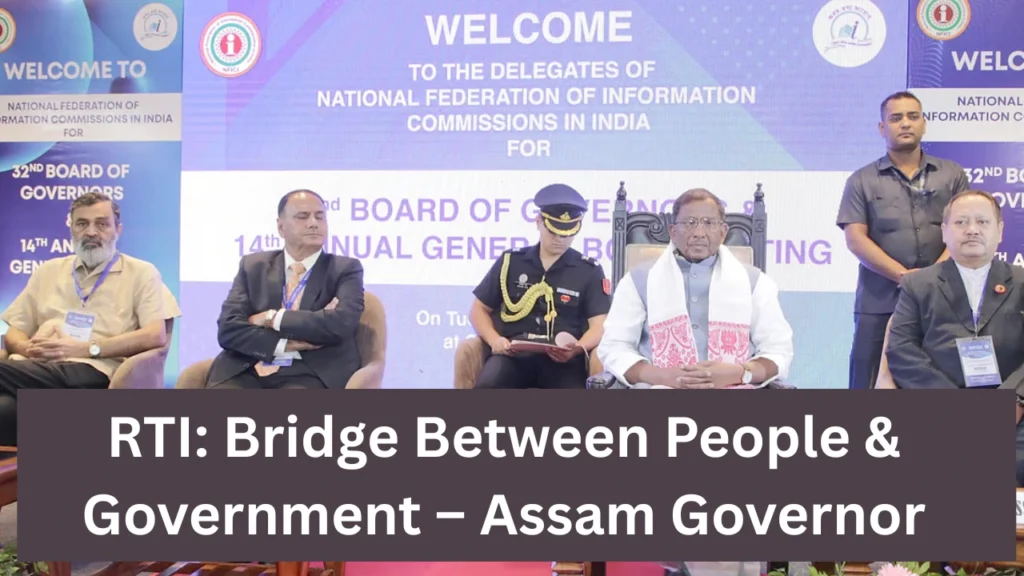Guwahati, Assam: Highlighting the transformative role of the Right to Information (RTI) Act, Assam Governor Lakshman Prasad Acharya on Tuesday said that the RTI Act functions as a crucial bridge between citizens and the government, enabling transparency, accountability, and democratic participation in governance.
The Governor made these remarks while inaugurating the 32nd Board of Governors and the 14th Annual General Body Meeting of the National Federation of Information Commissions in India (NFICI), held in Guwahati.

RTI Act – A Pillar of Democratic Empowerment
In his keynote address at the 32nd Board of Governors and 14th Annual General Body Meeting of the National Federation of Information Commissions in India (NFICI) held in Guwahati, Assam Governor Lakshman Prasad Acharya described the Right to Information (RTI) Act, 2005 as one of the most impactful democratic tools that India has adopted since independence.
The Governor emphasized that the RTI Act has played a pivotal role in empowering ordinary citizens by granting them the legal right to access information held by public authorities. This, he noted, has effectively narrowed the information gap between the public and the administration.
“The RTI Act symbolizes a transformative change. It acts as a bridge that narrows the gap between the common citizen and the government, allowing for greater participation in governance,” said Governor Acharya.
He further added that the law has revolutionized India’s democratic framework, ensuring that the people remain at the center of power, while compelling the government to function with transparency, efficiency, and accountability.
Positive Impact on Transparency, Corruption, and Service Delivery
Governor Acharya also highlighted the measurable benefits brought by the implementation of the RTI Act:
- Promotion of transparency in public administration
- Reduction in corruption across various departments
- Improvement in service delivery to citizens
- Increased accountability of government institutions
He acknowledged that marginalized and rural communities have particularly benefited, as the Act has given voice to the voiceless by enabling them to demand information and services that were once out of reach.
RTI in the Digital Age – A Call for Modernization
Speaking on the challenges and opportunities in the current era, Governor Acharya stressed the importance of adapting the RTI framework to the digital age. He called for:
- Making the RTI process more accessible and user-friendly through digital platforms
- Reducing paperwork and enabling e-RTI applications
- Integrating AI and data analytics to track RTI trends and improve responsiveness
- Encouraging transparent information sharing via public dashboards and government portals
“We must ensure that the RTI is not just a paper-based right but becomes part of public behavior and civic consciousness,” he remarked.
Need for Awareness & Grassroots Engagement
To make the Right to Information Act more inclusive, Governor Acharya advocated for:
- Widespread RTI awareness campaigns
- Organizing training programs and workshops at the grassroots level
- Special outreach to empower rural citizens, women, and marginalized groups
- Developing regional-language digital RTI platforms
Such initiatives, he noted, would strengthen democratic participation and ensure that every citizen—regardless of background—can leverage the RTI Act for justice and transparency.
NFICI Meeting Brings Together Information Commissions from Across India
The event in Guwahati marked the 32nd Board of Governors meeting and the 14th Annual General Body meeting of the National Federation of Information Commissions in India (NFICI). The gathering brought together:
- Chief Information Commissioner and NFICI President Heeralal Samariya
- Information Commissioners from various Indian states
- RTI experts, legal scholars, and administrative officials
The meeting served as a national platform to discuss the future of RTI in India, the integration of technology in governance, and the promotion of a transparency-first approach in public institutions.
Key Takeaways from the NFICI Guwahati 2025 Meeting
- RTI Act is central to Indian democracy and good governance
- Digital tools must be adopted to modernize the RTI process
- Grassroots engagement is crucial to making RTI effective in rural India
- Transparency and accountability must become institutional values
- The role of Information Commissions is vital in defending citizens’ right to know
Conclusion: A Culture of Transparency in India’s Democracy
The NFICI meeting in Guwahati served as a powerful reminder of the RTI Act’s role in deepening democracy, fighting corruption, and empowering every Indian citizen. With forward-looking suggestions from Governor Lakshman Prasad Acharya and other dignitaries, the call to bring RTI into the digital age and extend its benefits to the remotest corners of India is louder and clearer than ever.
Frequently Asked Questions
What is the RTI Act 2005?
The Right to Information (RTI) Act, 2005, is an Indian law that empowers citizens to request information from public authorities, promoting transparency, accountability, and citizen participation in governance.
What did the Assam Governor say about the RTI Act in 2025?
At the NFICI 2025 meet in Guwahati, Assam Governor Lakshman Prasad Acharya stated that the RTI Act functions as a bridge between the people and the government, enabling a more transparent and participative democracy. He emphasized its role in reducing corruption, improving service delivery, and empowering rural citizens.
What is the NFICI?
The National Federation of Information Commissions in India (NFICI) is an apex body representing State Information Commissions and the Central Information Commission. It works to strengthen the implementation of the RTI Act across the country.
What was the main message of the NFICI 2025 meeting?
The main focus of the 32nd Board of Governors and 14th Annual General Body Meeting of NFICI, held in Guwahati, was to promote transparency, modernize the RTI system through digital platforms, and make the Act more accessible and inclusive, especially in rural and marginalized areas.

